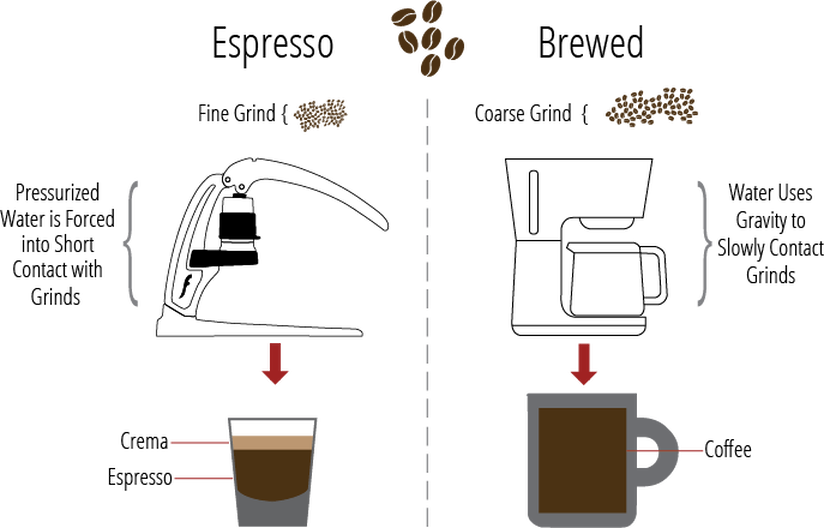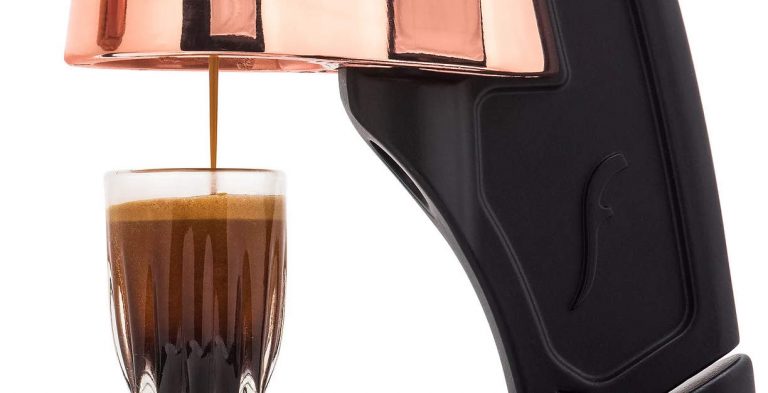Espresso Guide
Espresso 101: Learn the Basics of Espresso
What is Espresso?
Espresso is a method of brewing coffee, otherwise known as an extraction method. It is not a specific coffee bean or roast type! The major difference between espresso and other coffee brewing methods is pressure. To brew espresso, hot water is forced through a bed of finely ground coffee at high pressure, typically between 6 and 9 BAR. The contact between the coffee and the water at pressure results in a higher level of extraction, meaning that the natural oils and gasses in the coffee grounds are drawn out. The result is a stronger, more robust, but smaller coffee beverage with a layer of natural foam on top, called crema.
While espresso is higher in caffeine, per ounce, than regular brewed coffee, one or two shots of espresso normally will have less caffeine overall than an 8oz cup of brewed coffee.

What is Crema?
Crema is the thick layer of foam that gathers on the top of a correctly brewed shot of espresso. This foam is the result of carbon dioxide in your grounds that is off-gassed and initially dissolved into solution as the pressurized water passes over the freshly ground coffee. Then as the liquid returns to atmospheric pressure, that carbon dioxide comes out of solution forming bubbles that become wrapped with a liquid film composed primarily of emulsified oils and small bean fragments, or fines.
Crema blooms in your cup in what is known as the Guinness effect, as can be seen in the image below. While all espresso should have some crema in the cup, the amount of crema from a correctly brewed shot can differ based on roast levels and bean type. In general, Arabica beans typically feature less crema than Robusta beans, and lightly roasted coffees will typically have less crema than medium or dark roasts. Additionally, the color of the foam will reflect the strength of the beverage, as it is ‘colored’ by the refraction of light through the foam.

Why is Crema Important?
At Flair, we use crema as a simple success indicator. While not the most important aspect of brewing, seeing crema bloom in your cup means that you have succeeded in combining the baseline inputs needed for extraction. Not getting crema means that you may need to adjust one of the major inputs to brewing espresso with Flair: your coffee beans, your grinder, resistance in your coffee bed, and water temperature, as seen below.
- Crema and Your Coffee Grounds – As mentioned above, the amount of crema you achieve can be dependent on the coffee that you’re using. While light roasts may have less crema than darker roasts, if you don’t see any crema in your cup, you should check your beans to ensure they are freshly roasted. Look for ‘Roasted On’ dates and ignore the ‘Good By’ dates, as those tend to be extremely optimistic. Specialty (craft) coffee roasters rarely place ‘Good By’ dates on their bags of coffee. For the best extraction, use beans that have been roasted within two weeks of brewing. Additionally, make sure that your beans are ground immediately before brewing. If you buy pre-ground coffee, you’ll almost never get crema, as the CO2 in whole beans naturally releases over time, but almost immediately upon grinding. Once beans are ground you have a matter of minutes before the bulk of the remaining CO2 escapes.
- Crema and Your Grinder – Your grinder is incredibly important in ensuring that you reach proper extraction from your Flair and see crema in your cup. Aside from the importance of your grind size itself, we must also address the quality and type of your grinder for fine espresso grind. We recommend using a high quality burr grinder, with precise steps, or adjustments, of roughly .02mm, like our Royal grinder. A burr grinder like this, with metal burrs, can help ensure consistent grounds, which will yield a consistent extraction.
- Crema and Resistance – You can’t get crema without pressure, and the way you build pressure with the Flair is by ensuring that your coffee grounds are fine enough to create proper resistance to the flow of your brew water. This way, the water can only be forced through at higher pressure, which is the prerequisite for espresso brewing. If you don’t see crema in your cup, and your lever is easy to lower, it is most likely because you haven’t ground your beans fine enough. At the correct resistance levels, you should be brewing at between 6 and 9 BAR pressure for between 35 and 45 seconds. This is our starting recommendation, but we encourage you to experiment from here once you’re dialed in to a great looking, but most importantly great tasting espresso!
- Crema and Temperature – Your brew temperature, along with your pressure, is what facilitates the emulsification of the oils in your coffee grounds while brewing. If you’re not seeing crema, it’s possible you’re brewing at too low a temperature to ensure proper extraction at your brew times.



